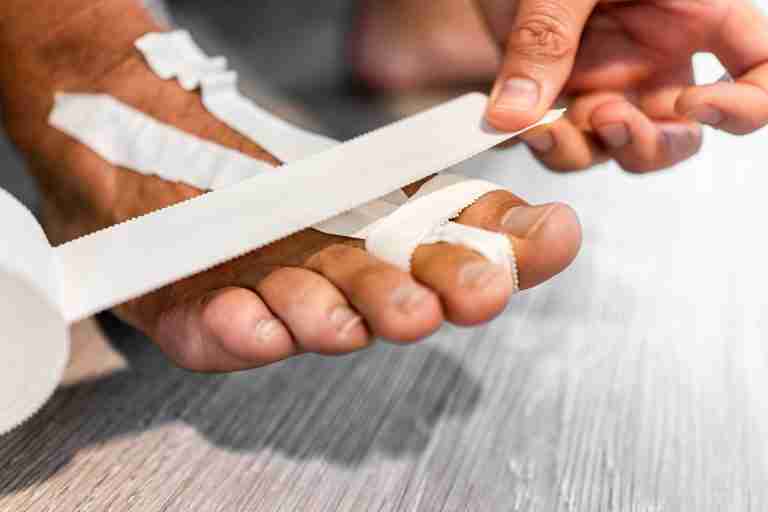Cohesive Bandage Wraps: 5 Useful Applications In Healthcare
In this article, we describe what cohesive bandage wraps are and how they are used in healthcare generally and sports medicine in particular.
What Are Cohesive Bandage Wraps?
Cohesive bandage wraps are bandages made from material that will stick only to itself. This is in contrast to adhesive wraps, which stick not only to themselves but also to the patient’s skin, clothes etc.
Application of these wraps is as simple as wrapping them around the affected limb or joint and allowing the layers to stick together naturally. Applied in this way, cohesive bandage wraps can be used to apply both compression (for treatment of swelling and inflammation, for example) and support (in order to take pressure off injured soft tissues and allow them to heal naturally.
Cohesive bandage wraps usually come in widths of 2″ or 3″ (as does DynaPro SelfWrap, for example), although they are sometimes also sold in widths of 1″ and 4″. Typical colours are white or beige but some manufacturers also produce them in other colours such as black, for example.
5 Healthcare Applications Of Cohesive Bandage Wraps
We will now move on to describe 5 popular applications of these wraps in sports medicine.
Cohesive wraps are widely used in healthcare for their versatility and effectiveness in a variety of applications. Here are five popular uses of cohesive bandage wraps in the healthcare industry.
- Compression Therapy: Cohesive bandage wraps are commonly used in compression therapy to control and reduce edema (swelling). The cohesive nature of these bandages allows them to adhere to themselves without the need for adhesive, making them easy to apply and remove. Applying a cohesive bandage wrap with adequate pressure helps promote blood circulation, prevent fluid buildup, and reduce swelling in injured or post-surgical areas.
- Wound Dressings: Another popular application of cohesive bandage wraps is in wound management. These bandages provide an ideal primary or secondary dressing due to their breathable and flexible nature. They can conform to various body contours, ensuring proper wound coverage and protection. Additionally, cohesive bandage wraps are hypoallergenic, thus minimizing the risk of skin irritation or allergies.
- Sports and Orthopedic Supports: Athletes commonly use cohesive bandage wraps as a supportive aid for joints and limbs. These bandages offer excellent stability and immobilization when applied properly. From ankle sprains to wrist injuries, cohesive bandage wraps provide compression and support, helping to relieve pain and prevent further damage. The self-adherent feature of cohesive bandage wraps ensures that they stay securely in place during physical activities.
- Splinting: Cohesive bandage wraps are also utilized in splinting procedures. When combined with a rigid splint, the bandage provides additional support and immobilization to fractures or injuries. It allows for easy adjustment and a snug fit, ensuring proper alignment and alignment while providing comfort to the patient.
- Veterinary Care: Cohesive bandage wraps are not limited to human healthcare; they are extensively used in veterinary care as well. These wraps are a go-to choice for splinting, wound management, and compression therapy in animals. Their versatility and ease of use make them a valuable tool in treating various injuries and promoting healing in veterinary medicine.
In the healthcare industry, cohesive wraps have become an essential tool due to their wide range of applications. Whether it is for compression therapy, wound dressings, sports supports, splinting, or veterinary care, these wraps offer remarkable benefits. Their self-adherent properties, comfort, and flexibility make them a reliable and convenient option in providing effective healthcare.
Cautionary Note
It should be noted that caution is in order when using these bandages for compression therapy as outlined above. In certain situations, their use can restrict blood circulation and present a serious health risk to the patient. Accordingly, patients should, whenever possible, apply these bandages for compression therapy in the presence of a qualified healthcare practitioner.
If the cohesive bandage wrap has to be applied without a doctor’s supervision, care should be taken by the patient to monitor for any unusual sensations such as numbness, prickling, heat, cold or even a loss of sensation. It is important to remember that these may occur at a distance from the site at which the wrap is situated. If any of these symptoms is experienced, the patient should remove the wrap immediately and consult with his or her doctor.
Conclusion
In this article, we have described cohesive bandage wraps and listed 5 of their most popular applications in healthcare, including compression therapy, wound dressings, sports supports, splinting and veterinary care. We hope that this information is useful to the reader.
Please remember to leave questions or comments in the space provided below.








